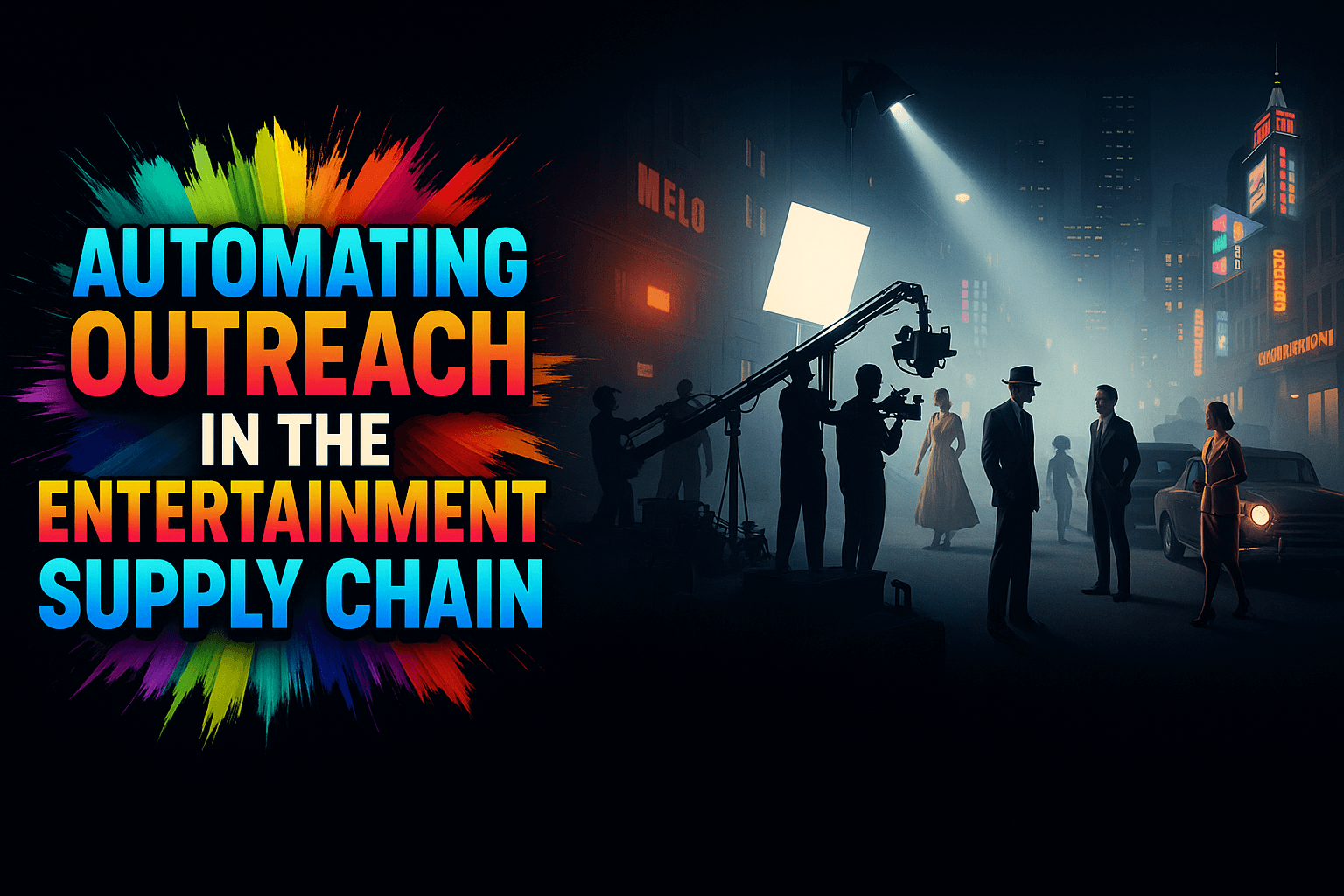The Executive’s Guide to Automating Outreach in the Entertainment Supply Chain

Introduction
The entertainment industry, valued in the trillions of dollars, operates on a complex web of partnerships, deals, and professional relationships. For decades, the process of finding and engaging with potential partners—from content creators to financiers to post-production houses—has been a manual, resource-intensive task driven by personal networks and fragmented data.
However, as the global supply chain becomes more intricate, this manual approach creates significant bottlenecks, leading to missed opportunities and a higher cost of doing business.
The solution is no longer a luxury but a necessity: automating outreach in the entertainment supply chain. This article will provide a strategic framework for how to implement a smarter, more efficient business development process that leverages data and technology to de-risk your pipeline and accelerate growth.
Key Takeaways
| Core Challenge | Manual outreach is time-consuming, inefficient, and fails to provide a scalable way to find and engage with partners across the fragmented M&E supply chain. |
| Strategic Solution | Implement an automated, data-driven system to identify, segment, and engage with high-value prospects, freeing up executive time for strategic tasks. |
| Vitrina’s Role | Vitrina’s platform provides the verified, real-time data on companies, projects, and executives that serves as the essential foundation for any successful automation strategy. |
The Inefficiencies of the Manual Outreach Model
For years, M&E business development has relied on a manual, “rolodex” model.
Executives and their teams spend countless hours on time-consuming tasks like:
- Sourcing leads: Manually searching for new companies, executives, or projects through a mix of web searches, trade publications, and fragmented databases.
- Data verification: Cross-referencing LinkedIn profiles with company websites and press releases to confirm contact details and roles.
- Personalization at scale: Writing individual emails for each prospect, which is an inefficient process and is not a scalable model.
- Pipeline management: Manually tracking a complex web of interactions in spreadsheets or basic CRM systems, a method that is prone to human error and data loss.
According to a 2022 survey by Ampere Analysis, the average M&E executive spends over 30% of their time on these manual research and due diligence tasks, much of which involves trying to cross-reference fragmented data from multiple sources.
This reliance on manual labor is not only inefficient but also creates a significant competitive disadvantage. Without a scalable system, companies can only pursue a limited number of opportunities, often missing high-value prospects and delaying time-to-market for projects. It’s a key reason why many executives struggle with the broader pain points in the entertainment supply chain.
A Strategic Framework for Automated Outreach
Automating outreach in the entertainment supply chain is a multi-step process that requires a strategic approach. It’s not about replacing human interaction with robotic messages; it’s about replacing inefficient manual tasks with smart, data-driven systems. I propose a three-pillar framework for this transformation.
Pillar 1: Data as the Foundation
The success of any automation strategy is directly tied to the quality of the data it’s built upon. Instead of relying on guesswork, your team needs a clean, verified, and centralized source of information.
This includes:
- Accurate contact information for executives.
- Verified company details, including their ownership, subsidiaries, and key decision-makers.
- A comprehensive, real-time view of their current projects (e.g., in development, in production, etc.) to ensure your outreach is timely and relevant.
Pillar 2: Intelligent Prospecting & Segmentation
With a solid data foundation, you can move beyond a one-size-fits-all approach. Automation enables intelligent segmentation, allowing you to tailor your outreach to specific groups of prospects.
Instead of sending a generic message to 1,000 people, you can send highly personalized emails to 100 people who fit a precise profile (e.g., all companies currently seeking co-production partners for a sci-fi series). This level of precision increases your response rate and improves your chances of converting a prospect into a partner.
This approach also helps address the complexities of cross-border transactions and building trust with new partners. For more on this, consider reading our analysis on the pain points in cross-border transactions.
Pillar 3: Automated Engagement & Follow-Up
Once you have identified and segmented your audience, automation tools can handle the repetitive tasks of outreach and follow-up.
A well-designed sequence can:
- Send an initial personalized email.
- Automatically follow up if there is no response.
- Notify your team when a prospect opens an email or clicks a link.
- Nudge your team to make a follow-up call at the optimal time.
This ensures no lead falls through the cracks and frees your team to focus on the human-centric parts of the business—the high-value conversations that close deals.
How Vitrina Transforms Your Outreach Strategy
Vitrina was built to serve as the critical first pillar of this framework—the data foundation. The platform eliminates the need for manual, fragmented research by providing a single source of verified metadata on over 3.3 million companies and 3 million executives. This is how Vitrina facilitates the automation of outreach in the entertainment supply chain:
- Real-time Lead Generation: Vitrina’s Project Tracker and search engine allow you to build hyper-specific lead lists based on real-time data. For example, you can identify every production company with a live project seeking a distribution partner, giving you a precise list for targeted outreach. Learn more about the Vitrina Project Tracker here.
- Data-Powered Segmentation: The platform’s granular filtering capabilities enable you to segment your leads with a level of detail previously impossible. You can create lists based on genre, budget, stage of production, location, and the historical collaboration patterns of key executives.
- Seamless Integration: Vitrina’s data can be exported and integrated into your existing CRM or marketing automation tools. This means you can transfer your verified lead list directly into a system like Salesforce or HubSpot, where your automated sequences can take over. This capability is what transforms manual business development into a scalable, automated pipeline.
By providing a clean, verified, and comprehensive data source, Vitrina allows you to build a business development machine that operates with a fraction of the manual effort.
Conclusion: The Future of Business Development
The manual era of business development in the entertainment industry is ending. Companies that continue to rely on personal connections and fragmented data will struggle to compete with those that have embraced a strategic, data-driven approach to automating outreach in the entertainment supply chain.
The future belongs to those who view business development as a scalable, repeatable process powered by quality data and intelligent automation. Platforms like Vitrina provide the essential foundation, giving executives the verified information and tools they need to build a robust pipeline, accelerate deal flow, and stay ahead of the curve.
Frequently Asked Questions
An automation sequence is a pre-planned series of messages (e.g., emails, social media messages) sent to a prospect over a set period. It is designed to nurture a lead without manual intervention, saving time for the business development team.
Marketing automation typically focuses on lead generation and nurturing a prospect until they are “sales-ready.” Sales automation focuses on streamlining the tasks of the sales team, such as sending follow-up emails, scheduling meetings, and managing a pipeline.
Yes, modern automation tools are designed to work with high levels of personalization. You can use data points like a prospect’s name, company, and project history to automatically insert personalized details into an email, making it feel custom-written.

























